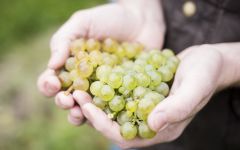Red Newt Cellars Kelby James Russell Dry Rose 2015


Product Details
Your Rating
Somm Note
Winemaker Notes






David and Debra Whiting met in the late 1980s when David was working as cellar master at a Finger Lakes winery and Debra was supervising microbiology labs at Cornell University. David’s oenological career blossomed as he worked at three different vineyards in Finger Lakes and Debra’s passion for food led her to start a gourmet cheesecake business and then an upscale catering company. The couple founded Red Newt Cellars in 1998 and Debra opened the Red Newt Bistro alongside the first wine releases in June of 1999. In 2011 Debra’s life was sadly cut short, prompting David to delegate some of his duties and hire a winemaker. In 2014 Kelby Russell, a Finger Lakes native, joined the team as the head winemaker.
Today, the Red Newt Cellars winery and Bistro are located in the small town of Hector in the Finger Lakes region of New York, on the southeastern corner of Seneca Lake. At 600 meters below sea level, Seneca Lake is the deepest of the Finger Lakes and one of the deepest lakes in the United States. The effects of the lake and the resulting range of surrounding altitudes and soil types create a wide array of unique terroirs in a relatively small area.
All of the vineyards Red Newt work with for their vinifera program are located on and around the Lake. To the Northwest, Nut Road is comprised of limestone and sandstone and produces an aromatic, delicate Loire Valley-style Cabernet Franc used for Kelby’s rosé. To the west sits Lahoma Vineyard, Red Newt’s largest vineyard. This land is all sandstone and is one of the highest vineyards in the area. The Knoll, a parcel within Lahoma Vineyard that is used to grow the benchmark Riesling for Red Newt, is the highest point at 1,600 ft. Nearby, lower-lying vines provide grapes for some of the other wines including the Circle Riesling and the Dry Riesling. Near the bottom of the lake is Tango Oaks, a compelling site that is a flood plain offering a mix of silt and loam on top of the bedrock. This site features Riesling planted to Alsatian clones, as opposed to the more typical German style Geisenheim ones, which brings an interesting tropical fruit finish to wines from this spot. The east bank of the lake is called the “Banana Belt,” a reference to its warm climate that farmers used to joke was well situated for banana growing. This microclimate is where you’ll find Red Newt’s red varieties, Cabernet Franc and Merlot.

Whether it’s playful and fun or savory and serious, most rosé today is not your grandmother’s White Zinfandel, though that category remains strong. Pink wine has recently become quite trendy, and this time around it’s commonly quite dry. Since the pigment in red wines comes from keeping fermenting juice in contact with the grape skins for an extended period, it follows that a pink wine can be made using just a brief period of skin contact—usually just a couple of days. The resulting color depends on grape variety and winemaking style, ranging from pale salmon to deep magenta.

As the most historic wine-producing region in New York state, winemaking in the Finger Lakes area dates back to the 1820s and today as a region, accounts for 90% of the state’s total wine production.
Its narrow and deep lakes created by the movement of Ice Age glaciers create an environment similar to the classic Riesling-loving regions of Europe, namely Germany and Austria. The Finger Lakes retain summer heat that incidentally warms up cold winter air, making it fall down from the lakes’ steep slopes. When spring comes, the lakes, already cooled by cold winter weather, stave off vine budding until the danger of frost has subsided. The main lakes of the zone, that is those big enough to moderate the climate in this way, are the focal points of prime vineyard areas. They include Canandaigua, Keuka, Seneca and Cayuga.
While Riesling has fueled most of the region’s success, today Pinot Noir and Cabernet Franc enjoy some attention.
